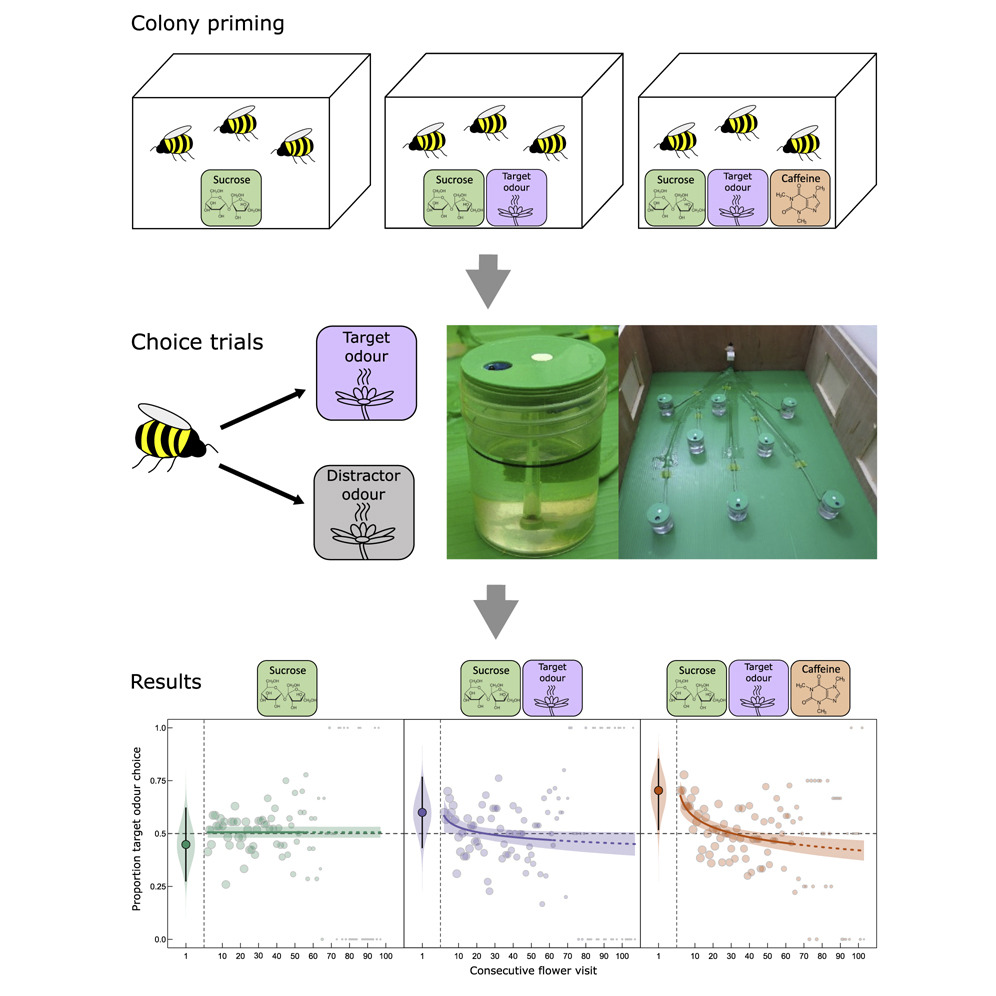Bumble bees show an induced preference for flowers when primed with caffeinated nectar and a target floral odor
Sarah E.J.Arnold, Jan-HendrikDudenhöffer, Michelle T.Fountain, Katie L.James, David R.Hall, Dudley I.Farman, Felix L.Wäckers, Philip C.Stevenson
当你需要学习的时候,没有什么比一杯浓咖啡更好的了。蜜蜂似乎也如此。它们在食用自己最喜欢的含咖啡因花蜜时,能学习得更好。
一项新研究发现,给大黄蜂喂食咖啡因有助于它们更好地记住含有花蜜的特定花朵的气味。之前有研究发现,蜜蜂喜欢咖啡因,会更频繁地去吃含咖啡因的花蜜。此次,研究人员首次发现,在巢中摄入咖啡因实际上有助于蜜蜂在巢外找到特定的花。7月28日,相关论文发表于《当代生物学》。
“当你给蜜蜂咖啡因时,它们似乎更有动力和效率了。”英国格林威治大学自然资源研究所(NRI)研究员Sarah Arnold说,“我们想知道,提供咖啡因能否帮助它们的大脑,在特定花香和糖奖励之间产生积极的联系。”
对蜜蜂来说,选择最好的花朵作为食物并不容易。“例如对大黄蜂而言,这相当具有挑战性。因为它们的视野不够广泛,于是需要依赖很多线索,比如嗅觉,才能找到好的花。”Arnold说。
科学家们已经知道,咖啡和柑橘等植物中天然存在咖啡因,这有助于将蜜蜂转变为其花朵的忠实“顾客”。但之前大多数实验主要设计为在花朵上提供咖啡因,在这种情况下,蜜蜂表现出对含咖啡因花蜜花朵香气的偏好。但这很难确定咖啡因的作用:是吃了咖啡因的蜜蜂记忆力更好,还是它们只是渴望咖啡因?
为了回答这个问题,Arnold团队(包括来自NRI和英国园艺研究组织NIAB EMR的研究人员)决定在巢穴中就给蜜蜂咖啡因,并让蜜蜂学会将特定气味(一种模仿草莓花香的合成气味)与美味糖溶液联系起来。之后,当它们被放出去寻找食物并选择了有草莓香味的花时,蜜蜂会得到含糖但不含咖啡因的花蜜。
博士后研究员Jan-Hendrik Dudenhoffer将86只以前没有受过训练的蜜蜂(大黄蜂)分为三组。他给了第一组蜜蜂草莓花香和含咖啡因的糖溶液;给第二组草莓花香和糖溶液,让它们知道两者之间的积极联系,但没有咖啡因刺激;给第三组糖溶液,没有任何相关气味。
然后,他把蜜蜂放在一个实验场中,让它们在两种机器花中进行选择:草莓香味的花和其他气味的干扰性花。
如果蜜蜂没有了解到草莓花香和花蜜奖励之间的关系,那么它们“访问”这两种花的可能性是一样的。然而,第一组蜜蜂中,有70.4%的会先去草莓香味的机器花——这远远高于偶然。相比之下,在第二组蜜蜂中这一数字为60%,第三组为44.8%。这表明咖啡因确实能提高蜜蜂根据花香识别花朵,并记住这种花有其喜欢的花蜜的能力。
然而,这种偏好并没有持续太久。食用了含咖啡因糖溶液的蜜蜂很快就“克服”了对草莓花的偏好,开始同样地访问其他类型的花。
“这是我们可以预料到的,因为蜜蜂无论访问目标花还是干扰花,都能得到糖。”Arnold说,“在某些方面,它们忘却的速度和学习的速度一样快。”
研究人员还注意到,咖啡因对蜜蜂的“采蜜速度”或特定时间内拜访花朵的数量有微妙影响。虽然随着时间的推移,所有蜜蜂都变得更高效,但食用了咖啡因的蜜蜂的进步最快,这表明咖啡因也可能提高运动学习技能。
Arnold说,这些发现对农业有重大意义。例如,草莓种植户每年可能会购买几十箱,甚至数百箱商业蜜蜂,其中许多蜜蜂可能会飞向邻近的野花,而不是草莓花。而Arnold说,借助咖啡因让蜜蜂更喜欢目标植物,就能把野花资源留给野蜜蜂,草莓种植者在商业蜜蜂上投入的钱就更有价值了。这对各方来说都是双赢的。
来源:中国科学报 冯维维
Summary
Caffeine is a widely occurring plant defense chemical1,2 that occurs in the nectar of some plants, e.g., Coffea or Citrus spp., where it may influence pollinator behavior to enhance pollination.3,4 Honey bees fed caffeine form longer lasting olfactory memory associations,5 which could give plants with caffeinated nectar an adaptive advantage by inducing more visits to flowers. Caffeinated free-flying bees show enhanced learning performance6 and are more likely to revisit a caffeinated target feeder or artificial flower,7, 8, 9 although it is not clear whether improved memory of the target cues or the perception of caffeine as a reward is the cause. Here, we show that inexperienced bumble bees (Bombus terrestris) locate new food sources emitting a learned floral odor more consistently if they have been fed caffeine. In laboratory arena tests, we fed bees a caffeinated food alongside a floral odor blend (priming) and then used robotic experimental flowers10 to disentangle the effects of caffeine improving memory for learned food-associated cues versus caffeine as a reward. Inexperienced bees primed with caffeine made more initial visits to target robotic flowers emitting the target odor compared to control bees or those primed with odor alone. Caffeine-primed bees tended to improve their floral handling time faster. Although the effects of caffeine were short lived, we show that food-locating behaviors in free-flying bumble bees can be enhanced by caffeine provided in the nest. Consequently, there is potential to redesign commercial colonies to enhance bees’ forage focus or even bias bees to forage on a specific crop.




 位访客
位访客